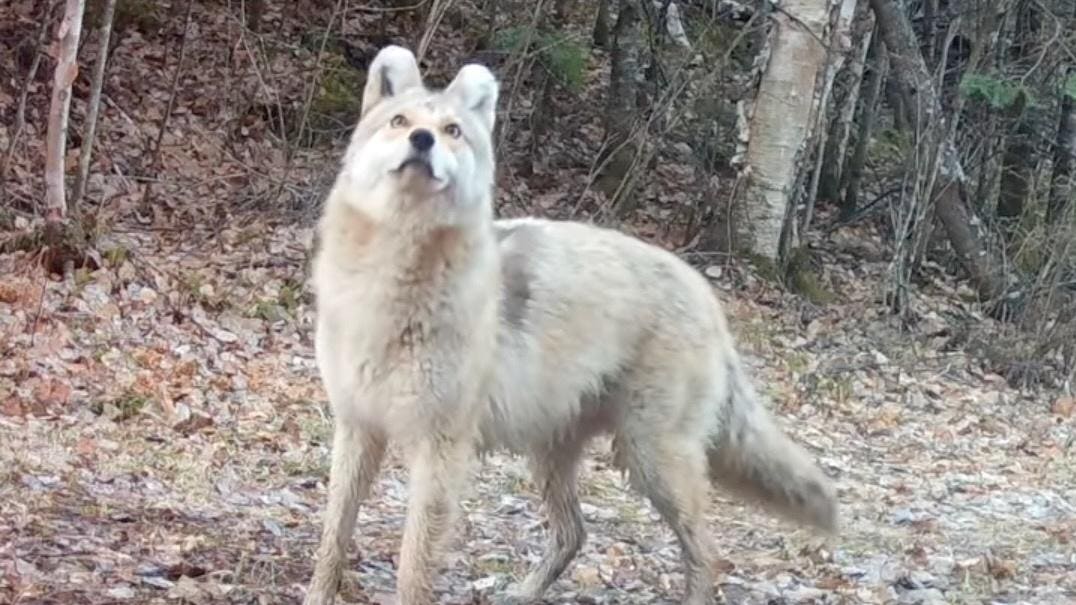This mysterious dog was spotted on a trail camera that monitors wolves in northern Minnesota.
Rounded ears. A beige and gray fur coat. A fluffy tail. This is the description for a mysterious animal caught on camera by Voyageurs Wolf Project in northern Minnesota. Researchers with the project shared footage of the dog on social media on Nov. 5 and asked for the public’s guesses as to what it is.
Check it out for yourself:
The project joked that it could be a “woyote dog,” a mix of a dog, coyote, and wolf. “To us, the animal looks ‘coyote,’ but has some dog-like aspects of its appearance (especially its ears), and possibly some wolf-like characteristics (eg, strong snout, slightly larger body larger than coyotes in our area. …but these are also attributes of some dogs,” the project said. Coyotes usually have sharper ears.
One thing is certain. The dog is not a pure wolf, says project leader Thomas Gable via email. While the animal has a mixture of characteristics that resemble coyotes, wolves, and dogs, it is not necessarily a hybrid. “At the end of the day, we’ll never know for sure one way or the other because the animal just passed through our area in the winter and we haven’t seen it on any camera since then, so we can’t we get a genetic sample or something for it. tell it one way or another,” says Gable.
Commentators speculated what the animal could be. “It’s sad when people can’t make a textbook ID of a Yotedoodle,” one person joked on X. Another called her “North American Cutie Patootie.” Others thought it might be a wolf-dog cross. Domestic dogs can breed with wolves and coyotes. Facebook users wondered if the ears could have been damaged by the freeze. However, it is only a guess.
A follow-up social media post went into more depth on the difference between wolves and coyotes in northern Minnesota. Local wolves are much larger than coyotes. “The coyotes in this video are typical of what coyotes look like in our area – which is why the video of that mysterious coyote-looking-but-not-entirely-coyote-looking dog we shared yesterday caught our attention. “, it was said in the project.
The wolf project is run through the University of Minnesota. It covers wolves across the Greater Voyageurs Ecosystem, which includes Voyageurs National Park. The research was inspired by a question: What do gray wolves do in the summer? It is difficult to answer in part because of the dense forests in the area. An extensive network of wildlife cameras helps researchers understand how wolves eat, reproduce and raise their young.
GPS tracking collars are another key tool for the project, which monitors 16 wolf packs across the region. Scientists are particularly interested in finding kill sites where wolves eat their prey. When a collared wolf stands still, this is a sign that it may be eating. Researchers can then visit the site and look for signs of feeding that tell them what the wolves are eating. Wolves tend to take down their prey and leave little evidence behind.
The Voyageurs Wolf Project aims to inform wolf conservation and management decisions. Gray wolves are protected under the Endangered Species Act in most parts of the United States. “By gathering detailed information on both predatory behavior and the reproductive ecology of wolves, we are able to link critical aspects of wolf summer behavior to important ecological factors, prey populations, and human interactions,” the project said.
The mysterious canine intruder may remain an enigma, but there is still plenty of room for speculation. Anyone missing a funny looking dog in northern Minnesota?
